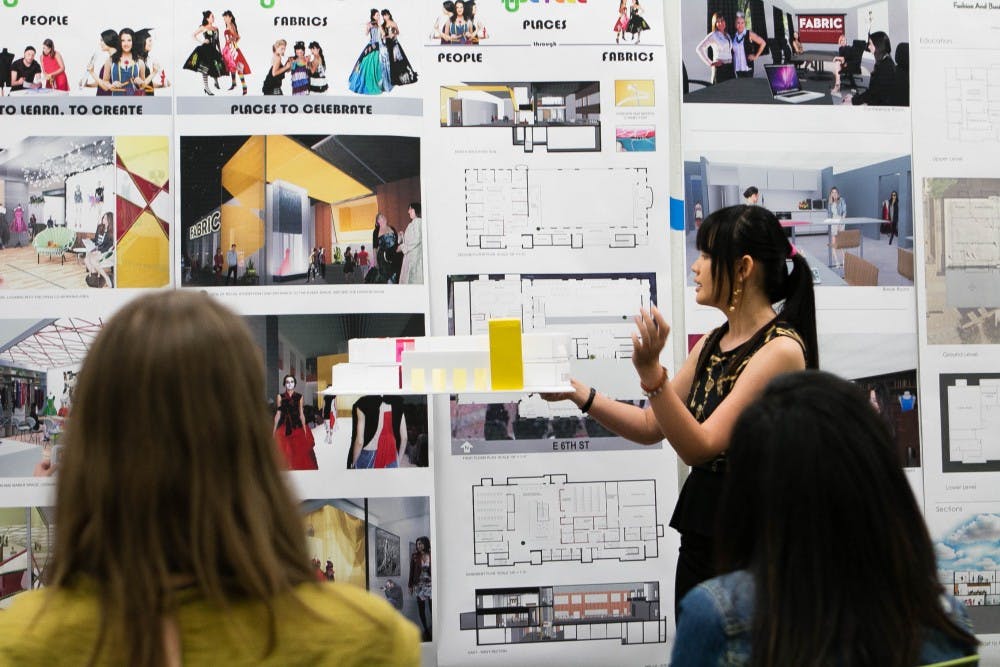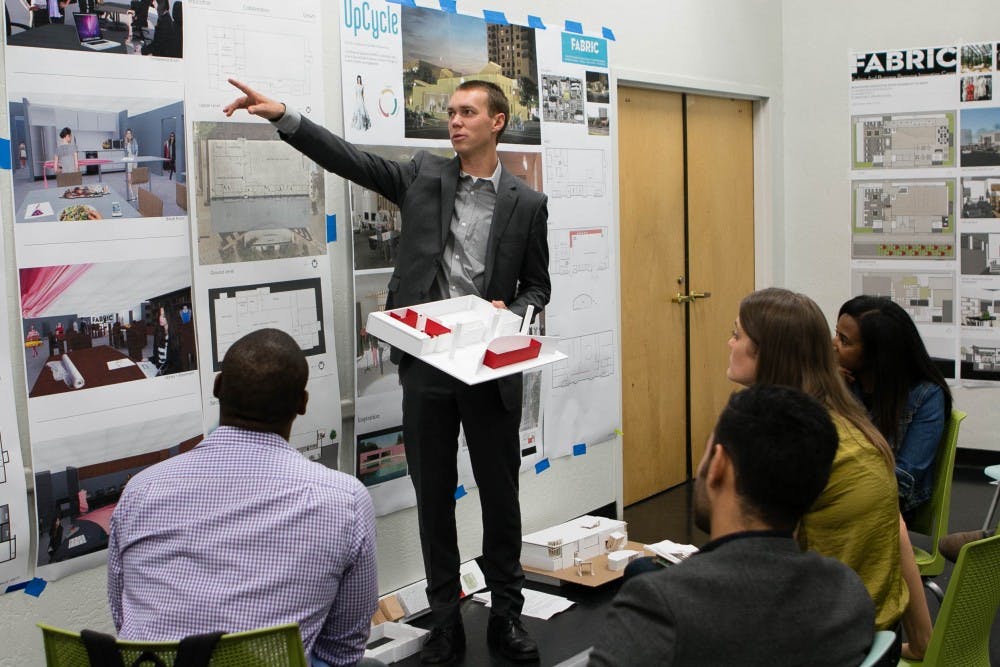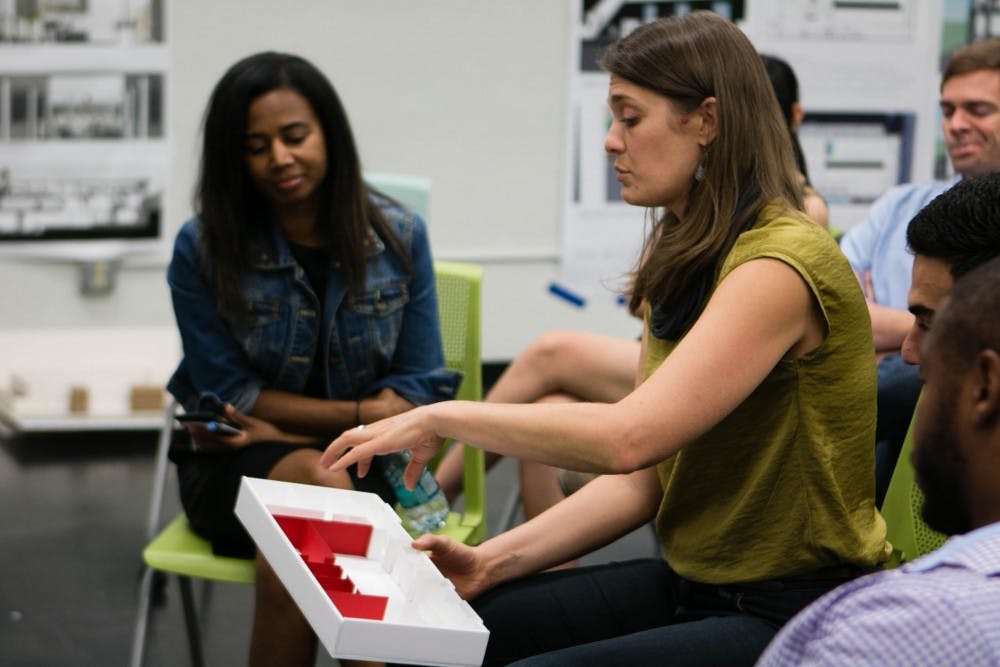The moment Angela Johnson and Sherri Barry opened the doors of the vacant Tempe Performing Arts building, they saw the perfect place to build their fashion empire.
Looking past the cobwebs and dust piling in the corners, Johnson and Barry envisioned a creative space for designers to work and come together. Almost a year and a half later, the Fashion and Business Resource Innovation Center, otherwise known as FABRIC, is one of the most prominent fashion creative spaces in Phoenix, hosting runways shows. FABRIC offers classes and gives designers a place to hone their craft.
Now, the building is coming to life once more, as students within Arizona State University’s architecture design program submit proposals for renovations and improvements to the multi-story building.
“The beauty of having the architecture students here is that they have ideas we never could have dreamt up ourselves,” Barry says. “They have come up with ideas for many of the rooms within the space that will really help designers.”
Exploring FABRIC
The large red brick building stands on the corner of Forest Avenue and Sixth Street in downtown Tempe. Visitors enter a small enclosed courtyard before pulling open the glass doors. From there, they’ve entered into the fashionable maze that is FABRIC.
In the lobby, an arrangement of chic white furniture greets them, complete with a furry white rug. Directly in front of them is the entryway to a large warehouse style room. In here, a long work table is covered in yards of multicolored fabric, spools of thread and various other fashion-related tools. Behind this workstation is a row of sewing machines, ready to hum into action.
Upstairs and in the basement is where classrooms and various classrooms interlock and coexist and turn the fashion incubator into a winding labyrinth.
However, this design is subject to change, thanks to ASU architecture students.
The Partnership
The founders of the fashion incubator are collaborating with President's Professor Max Underwood and ASU instructor Brie Smith to review new building proposals submitted by students.
“We don’t design in a vacuum,” Smith says. “It’s nice to have that energy. Sherri and Angela have persevered in this business and are great cheerleaders for our students, bringing with them their knowledge of the fashion world.”
Smith says she and Underwood have similar teaching philosophies, and that it is their job as instructors to support students, without taking over their ideas. At the end of the day, it’s about the real world experience her students can obtain through the school’s partnership with FABRIC.
FABRIC has always embraced their location on the ASU campus, promoting an open dialogue with the university and encouraging students to drop in and tour or apply for an internship.
“I love that we are on the ASU campus. The collaborations are endless,” Johnson wrote on her Facebook page.
The Proposals
The founders of FABRIC noticed many common themes among the designs, including a desire to open up parts of the building for better flow. Many of the architecture students also highlight the need to bring more natural light into the workspace and incorporate plans to promote visibility of the building from the street into their proposals.
“It was really about taking down the walls and expanding in order to create a unified co-working area for collaboration,” says first year interior architecture graduate student Rachel Frail about her presentation. “The goal is to stimulate continuous learning and refinement of skills among the different designers.”
Frail’s plans for the building include dropping the main event space from the main floor to the basement and creating a mezzanine on the second level connected by a grand staircase.
“I created a three story entryway, so when you enter off the street onto the ground floor you are right at the VIP area,” Frail says. “I dropped the main venue down into the basement, so that the two story section actually starts in the basement and goes all the way up to the second floor.”
Meanwhile, graduate designer Meghan Draper-Hiller drew inspiration from her love of fashion when drafting her proposal.
“I have a fashion design background,” interior architecture major Draper-Hiller says. “Coming in here was super exciting, and I wanted to go into every room and figure out what machine they had, and that was not the experience that everyone else had. I wanted to bring some of that joy —there is value in making.”
Her goal was to design a space that could better serve the community being built by FABRIC’s founders. Her design included many levels of layered skylights to connect the different spaces together.
“I was really happy with the skylights I created because it makes it seem like it was being stitched together, just like the community that is being built here and stitched together is so cool and interesting,” Draper-Hiller says.
When asked what she was most proud of, Draper-Hiller explained how her design for the office space made it look like a giant spool of thread. In order to promote visibility, she designed the spool to be easily viewed from the street.
“I was really happy with my gigantic rotating thread offices just because anyone who sews or is involved with that will see a spool of thread and be interested. You want to know what’s going on in there,” says Draper-Hiller.
Architecture design graduate student Stephen Davis was inspired by Johnson and Barry’s dedication to their craft and wanted to honor their devotion to the fashion industry in his design proposal.
“The people in fashion bring so much excitement and passion and dedication that I think they need to get some of that back from the building,” Davis says. “It’s about making this building an exciting place to be.”
Real World Experience
Both Barry and Johnson are happy to share their knowledge of the fashion industry with students. Coming from extensive fashion backgrounds, each worked to develop their own personal lines, Johnson in designing repurposed ball gowns, and Barry working on the executive and marketing side of the industry. Now, they are excited to offer students the opportunity to pitch design ideas that have the potential to inspire change within their company.
“As good as education programs are, it is very difficult to provide real life experience in the classroom,” Barry says. “At FABRIC, students get a chance to see a project through from A-Z. It’s not theoretical. It’s real.”
While putting together a detailed proposal might be challenging, students are facing the project head on. First year graduate designer David Shirk is excited to be able to incorporate fashion elements, like fabric material, into his designs.
“This is our first project, but it has been an interesting and challenging project,” Shirk says. “You get to use soft materials, like fabric, rather than a permanent material in the design. I’m glad we were able to incorporate things like that.”
Graduate students like Jazmine Salley have grown by being immersed in the professional work environment. The architect major has been able to showcase the opportunities her designs help foster for FABRIC.
“The highlights of the presentation were talking about the outreach of FABRIC and the opportunity to move outside of the community and to actually teach, if needed, as well as showcasing the flexibility they already have,” says Salley.
Salley is thankful for the architecture design program’s collaborative nature, especially their efforts to promote interaction between students and people in the workforce.
“It provided me opportunity,” says Salley. “I would never be able to do this at any other type of program. It gives me opportunity to do professional work while learning, so if I fail, it is a safe place to fail.”
While the program might be a safe space for students, Johnson and Barry say the group of architecture students have exceeded expectations with their designs. Students like Draper-Hiller credit her instructors for the success of the proposals, who inspired her to take her ideas further and think outside the box.
“It is a very rigorous design program,” Draper-Hiller says. “You get to be creative every day, and the teachers really encourage you to think about things in a different way. They push you to make your ideas bigger and to just keeping pushing the envelope.”
Next Steps
In the eyes of Johnson and Barry, the desire to keeping innovating and improving designs set these students apart from others. The founders of FABRIC are now looking to make the designs a reality and plan to submit the students’ proposals for grant approval.
“We are hoping that we can use one of these proposals to land a grant or something to actually make these changes to the building one day,” Johnson wrote on her Facebook page.
When asked by Johnson and Barry if they would continue to support the project through its next steps, the team of student architects all replied with enthusiasm, nodding their heads and shouting approval. Already, the team was thinking about how to combine their designs into one cohesive proposal.
“The next step is to take the common themes from each project, as well as the unique and innovative ideas from individual proposals, and put them together into one plan we can submit for grant qualification,” Johnson says.
With their eyes on the future, the architecture students, instructors and FABRIC’s founders are all helping to transform FABRIC by bringing new life into the building.
“Having fresh eyes and a collaborative discussion to see the investment FABRIC is making in the community is invaluable,” Smith says.
Keep up with all of FABRIC's projects by liking Fabric on Facebook or by following them on Twitter @FabricTempe.
Reach the reporter at Madison.Staten@asu.edu or follow @madisonmstaten on Twitter.
Like State Press Magazine on Facebook and follow @statepressmag on Twitter.






